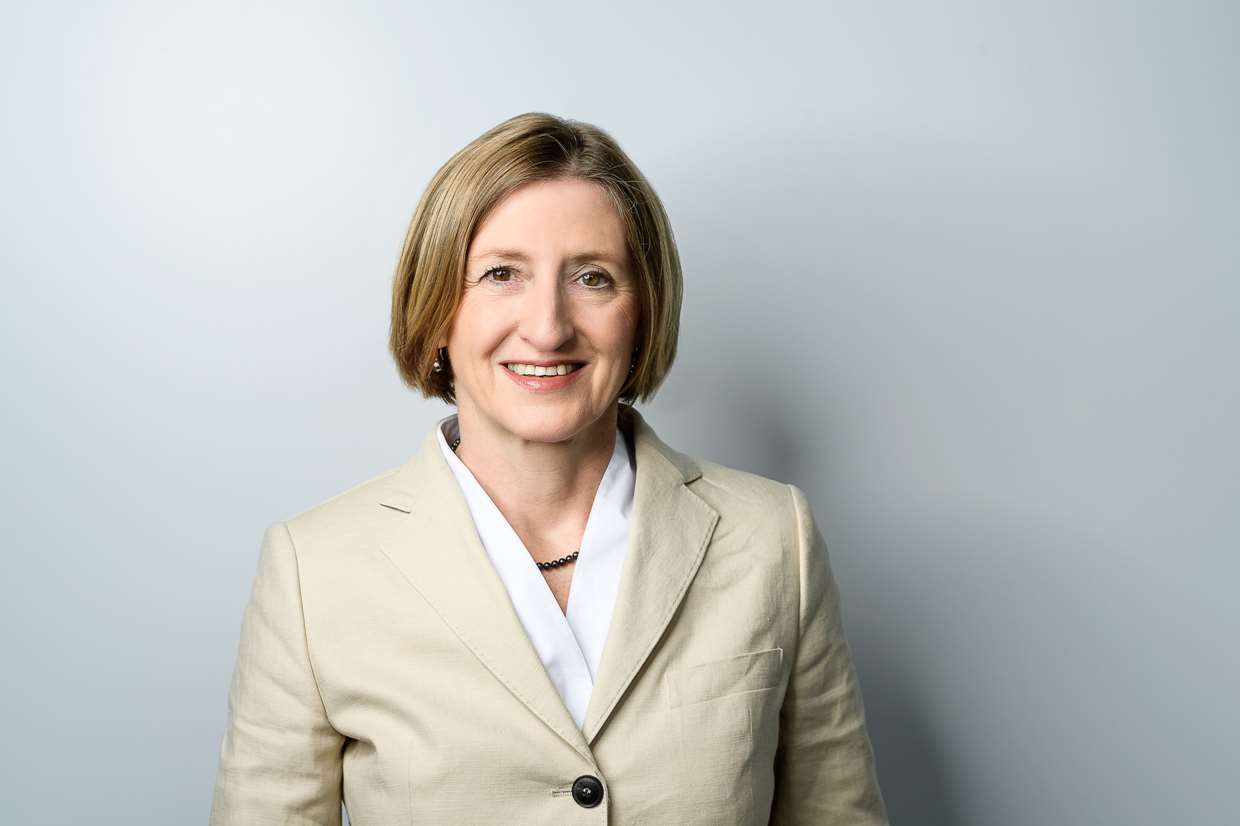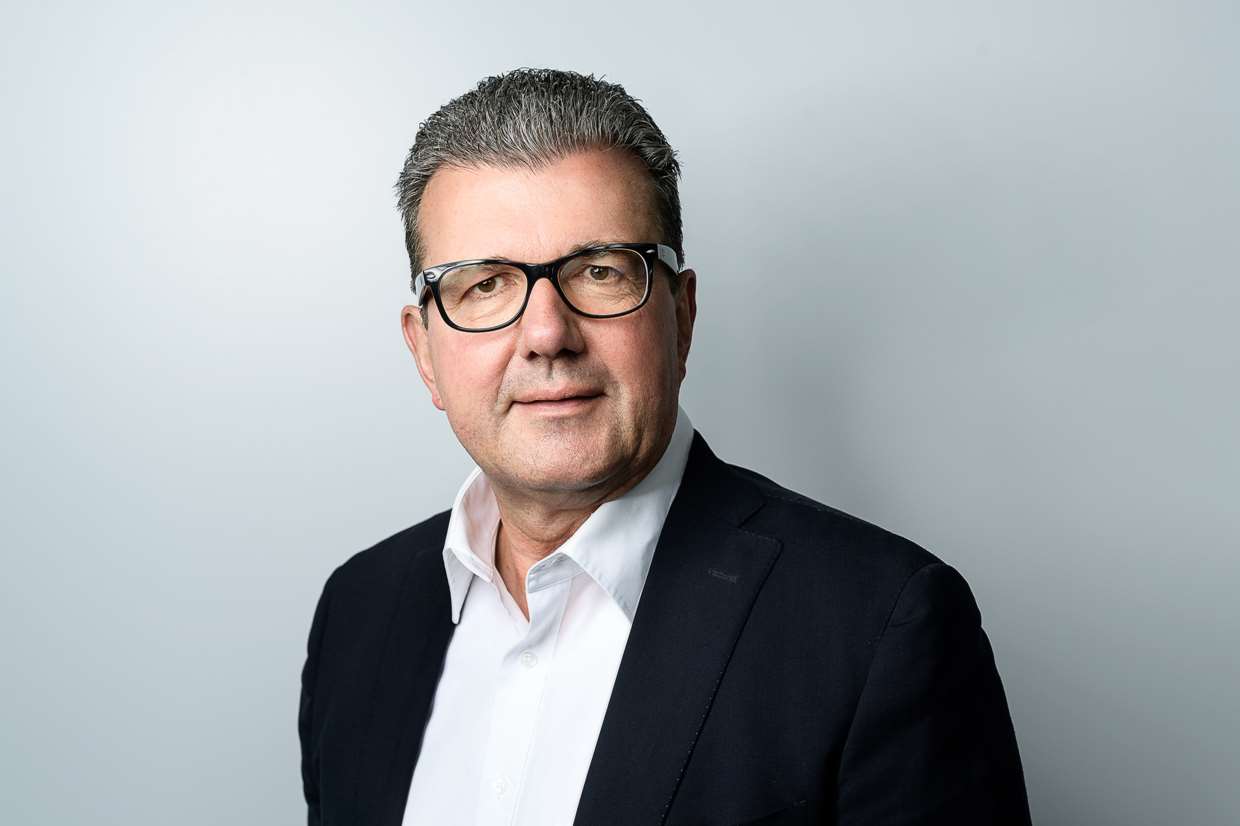3Board of Directors
3.1/3.2Members of the Board of Directors/Other activities and vested interests
The Board of Directors of HUBER+SUHNER AG must consist of at least five members. All members of the Board of Directors are non-executive. They do not participate in the executive management of the Group. They also do not have any significant business relationships with HUBER+SUHNER AG or other Group companies. No member of the Board of Directors has served as a member of HUBER+SUHNER Executive Group Management or one of its Group companies in the three financial years preceding the period under review.
At the Annual General Meeting on 31 March 2021 six acting members of the Board of Directors were re-elected.
On 31 December 2021 the Board of Directors comprised the following six members:

Education and professional background
Dipl. Ing. ETH (Swiss Federal Institute of Technology) Zurich. Senior Executive Program IMD, Lausanne. Project Manager, Production Manager and Head of Sales of Zellweger Uster AG, Uster and USA, 1987 to 1993. Joined HUBER+SUHNER in 1994: Managing Director of Henry Berchtold AG, a former subsidiary of HUBER+SUHNER AG, 1994 to 1997. Division Head and member of the Management Board of HUBER+SUHNER AG, 1997 to 2000. Member of Executive Group Management since 2001; Chief Executive Officer from 2002 to 31 March 2017.
Other activities and vested interests
Chairman of the Board of Directors of Schaffner Holding AG, Luterbach. Member of the Board of Directors of SFS Group AG, Heerbrugg; Vetropack Holding AG, Bülach as well as Müller Martini Holding AG, Hergiswil. Executive committee member of Swissmem and the Swiss Employers’ Association.

Education and professional background
Dr. sc. techn., dipl. Ing. ETH (Swiss Federal Institute of Technology) Zurich. MBA INSEAD, Fontainebleau. Various management positions with Elektrowatt Group, Stäfa and Zug, 1987 to 1997. SIG Schweizerische Industrie-Gesellschaft Holding AG, Neuhausen am Rheinfall, 1998 to 2004 and member of Executive Group Management as of 1999. Member of the divisional management board for packaging technology at Robert Bosch GmbH, Neuhausen am Rheinfall, 2004 to 2006. COO of the Komax Group, Dierikon, 2006 to 2007; CEO, 2007 to 2015 and Chairman of the Board of Directors, since 2015.
Other activities and vested interests
Chairman of the Board of Directors of Sevensense Robotics AG, Zurich and member of the Board of Directors of CabTec Holding AG, Rotkreuz.

Education and professional background
Dipl. math. of University of Zurich. Dr. oec. University of St. Gallen. Assistant Professor at the University of Tilburg, Netherlands, 1997 to 2001. Professor at the University of Lausanne, 1999 to 2004. Full Professor of Economics and Public Policy and Director of the Swiss Institute for Empirical Economic Research (SEW) at the University of St. Gallen from 2004 until January 2021. Honorary Professor at the University of St. Gallen from February 2021.
Other activities and vested interests
Member of the Board of Directors of Schindler Holding Ltd., Hergiswil and ACImmune, Lausanne. Member of the Bank Council of the Swiss National Bank, Zurich (until April 2022). Vice President of the Foundation Board, Gebert Rüf Stiftung, Zurich.

Education and professional background
Dipl. Ing. ETH (Swiss Federal Institute of Technology) Zurich. Product development and product management posts with ABB Transportation/Adtranz, Zurich, 1988 to 1998. Various line functions in product development and sales at Siemens Switzerland, Rail Automation, Wallisellen, 1999 to 2010. Vice President Sales at duagon AG, Dietikon, 2011 to 2013. Head of Sales at Ruf Telematik AG, Schlieren, 2013 to 2015. Managing Director at Kummler+Matter AG, Zurich, 2015 to 2017 and Head of Railway Signaling until 2018. Managing Director of BBR rail automation Swiss AG, Lucerne, 2019 to 2021. CEO of AlpRail GmbH, Gais, since 2014.
Other activities and vested interests
None

Education and professional background
Dr. iur. University of Zurich. Admitted to the Zurich bar. MBA from the University of St. Gallen and International Directors Programme at INSEAD in Fontainebleau. Many years of industry experience in various legal and commercial management positions. Bühler AG, Uzwil, 1999 to 2009. CEO/COO aizo group AG, Zurich/ Wetzlar, 2010 to 2011. Investment Director and member of the Executive Committee at EGS Beteiligungen AG*, Zürich, since 2012.
Other activities and vested interests
Chairman of the Board of Directors of Kantonsspital Winterthur, Winterthur; FAES AG, Wollerau as well as Roth Gerüste AG, Gerlafingen. Member of the Board of Directors of Sensirion AG, Stäfa.
*Significant shareholder at HUBER+SUHNER AG

Education and professional background
Lic. iur. University of Zurich. Admitted to the Aargau bar. MBA from the University of Chicago. Post-graduate degree from University of St. Gallen in European Economic Law. Advanced Management Program at University of Oxford. Management education in Business Strategy and Finance at Harvard Business School. Acquired many years of industry experience as a legal counsel and M&A expert to various multinational corporations: Danzas Management, Basel, 1991 to 1995. ABB Asea Brown Boveri AG, Baden and Oerlikon, 1995 to 2001. Novartis International AG, Basel, 2001 to 2009. Partner at Schärer Attorneys at Law in Aarau since 2010.
Other activities and vested interests
Chairman of the Board of Directors of Proderma AG, Schötz. Vice-Chairman of the Board of Directors of Zehnder Group AG, Gränichen and AEW Energie AG, Aarau. Member of the Board of Directors of SFS Group AG, Heerbrugg; Kraftwerk Augst AG, Augst; Immobilien AEW AG, Aarau as well as swissVR, Rotkreuz.
Honorary chairmen
Marc C. Cappis, 1935
David W. Syz, 1944
3.3Rules in the Articles of Association on the number of permitted activities pursuant to Art. 12 para.1 point 1 OaEC (Ordinance against Excessive Compensation at Listed Joint-Stock Companies)
As per Article 30 of the Articles of Association, a Member of the Board of Directors may hold up to 5 posts as a member of the management board or administrative body of other listed legal entities. In addition, a Member of the Board of Directors may hold up to 20 posts as a member of the management board or administrative body of non-listed legal entities and up to 10 posts as a member of the management board of foundations and associations.
3.4Elections and terms of office
According to the legal provisions, all Members of the Board of Directors, the Chairman and the members of the Nomination and Compensation Committee are elected annually and individually. The Articles of Association do not allow for any deviation from these election rules. The term of office of a Member of the Board runs until the end of the next Annual General Meeting. Re-election is possible. Please refer to 3.1/3.2 for the first election per member. Members of the Board cannot run for re-election at the Annual General Meeting in the year in which they turn 70 years of age. The Annual General Meeting also appoints the independent proxy representative each year. The term runs until the end of the next Annual General Meeting. Re-election is possible.
3.5Internal organisational structure
The Board of Directors exercises overall management, supervision and control over the running of the Group. Except for the election of the Chairman and the Members of the Nomination and Compensation Committee by the Annual General Meeting, the Board of Directors constitutes itself. The Board of Directors may appoint the Deputy Chairman from among its members. It may also appoint a Secretary from outside the ranks of the Board.
Working practices of the Board of Directors
The Board of Directors meets as often as business requires, but at least five times a year. The Chairman, or if he is unable to attend, the Deputy Chairman or another Member of the Board, chairs Board meetings. The Chairman convenes Board meetings and sets their agendas. He also ensures that Members receive the agenda at least 10 days in advance of the meeting, and decision material generally one week beforehand. In addition to the CEO, the CFO also attends Board meetings as a representative of Executive Group Management. Depending on the business at hand, other members of Executive Group Management may take part.
Decisions are taken by the Board as a whole. The Board shall constitute a quorum when the majority of its members are present. All decisions require a voting majority. In a tie, the Chairman shall have the casting vote. Voting by proxy is not allowed. All resolutions and agreements are minuted and approved by the Board.
Five regular Board meetings with an average duration of 5 hours, three additional telephone conferences with an average duration of three quarters of an hour, as well as one “strategy work-shop” lasting one and a half days, which was also attended by the entire Executive Group Management, were held during the year under review. The meetings took place at regular intervals during the financial year with a 100 % participation rate.
The Chairman of the Board regularly meets with the CEO to discuss current business performance and activities and makes decisions regarding the disclosure of price sensitive facts or the acceptance of posts outside the company by members of Executive Group Management. In addition, he is responsible for monitoring the implementation and compliance with resolutions taken by the Annual General Meeting and the Board of Directors and keeps the other members of the Board updated in a regular and timely manner. In addition to his core responsibilities, the Chairman performs additional duties for the HUBER+SUHNER Group, including liaising with key stakeholders and with the representative in the Foundation Committee or other organisations.
Committees – composition and working practices
The areas of responsibility and authority of the Nomination and Compensation Committee and the Audit Committee are defined in the appendix to the HUBER+SUHNER Bylaws. These committees support the Board in its supervisory and control capacities and function mainly as advisory, assessment and preparatory bodies. The members of the committees are as follows:
|
|
|
Nomination and Compensation Committee |
|
Audit Committee |
|
|
|
|
|
|
|
Beat Kälin |
|
Committee Chair (Member*) |
|
|
|
Urs Kaufmann |
|
Member (Committee Chair*) |
|
|
|
Monika Bütler |
|
|
|
Committee Chair |
|
Jörg Walther |
|
|
|
Member |
* until 31 March 2021
The committees meet as often as business requires, but at least twice a year. Minutes are taken at each meeting and sent to all meeting participants and to all Members of the Board of Directors. At the subsequent Board meeting, the Committee Chair briefs the Board and puts any motions to it.
The Nomination and Compensation Committee (NCC)
The committee consists of at least two non-executive Members of the Board elected annually by the Annual General Meeting, one of which will be designated as Chair by the Board of Directors. If the office of one of the members elected by the Annual General Meeting becomes vacant, the Board appoints one of its members to replace the departing member for the remainder of the term.
The committee prepares all the relevant decisions relating to nominating and compensating members of the Board of Directors and Executive Group Management and the Group’s compensation policy. The CEO attends the meetings, except if his own performance is under review or his own compensation is under discussion. Where necessary, the CHRO (Chief Human Resources Officer) is also present. The committee held two meetings with an average duration of 3 hours and a 100 % participation rate during the year under review.
The main duties of the Nomination and Compensation Committee are:
- managing the selection process and applications relating to new Board Members and the CEO;
- reviewing the selection process and applications relating to other members of Executive Group Management and core conditions of employment;
- drafting the compensation report;
- drafting proposals to be submitted to the Annual General Meeting as regards the remuneration provisions for the Board of Directors;
- reviewing and requesting the individual remuneration of the CEO and the other members of Executive Group Management in relation to the maximum compensation amounts approved by the Annual General Meeting;
- deciding upon the annual salary adjustments within the Group proposed by the CEO;
- briefing the Board of Directors on all NCC-related matters that are not in the immediate purview of the Board.
Audit Committee (AC)
The committee consists of at least two members. The Board of Directors appoints the members and designates the Chair annually. It supports the Board with financial management, supervision of accounting, financial reporting, internal auditing and cooperation with the external auditor. It decides on urgent technical matters. Areas of authority and responsibility assigned to the Board of Directors by law and by the Bylaws remain wholly within the Board.
The Chairman of the Board, the CEO, the CFO, the Head of Corporate Controlling and the external auditor usually attend committee meetings. Where necessary, the committee addresses certain agenda items with the external auditor alone. The committee held two meetings with an average duration of 3 hours and a 100 % participation rate during the year under review.
The Audit Committee has the following main tasks:
- reviewing the design of the accounting system and compliance with regulations and standards and, if necessary, proposing amendments for the attention of the Board of Directors;
- reviewing the yearly and half-yearly financial statements and other financial information to be published;
- monitoring risk management and the effectiveness of the internal control system (ICS);
- verifying the controlling system;
- monitoring compliance with internal regulations and policies, relevant legislation and compliance, in particular with regard the SIX Swiss Exchange;
- verifying performance, independence and payment of the external auditor, and handling audit reports and election recommendations for the attention of the Board of Directors;
- setting the audit plan for internal auditors and dealing with their audit reports;
- briefing the Board of Directors on all Audit Committee-related matters not in the immediate purview of the Board;
- reviewing the yearly environmental reporting/sustainability report.
3.6Definition of areas of responsibility
The areas of authority and responsibility of the various bodies are set out in the Bylaws (available under Corporate Governance).
The Board of Directors issues guidelines for business policy and makes decisions about all matters that are not reserved for, or assigned to, the Annual General Meeting or another company body by law, by the Articles of Association or the Bylaws. In particular, the Board of Directors approves the business strategy and organisation proposed by Executive Group Management, as well as budgets, medium-term plans, acquisitions and other business which, by its nature or financial impact, is considered strategically significant. Written requests are prepared for all projects that require a decision by the Board. The Board of Directors delegates the Group’s operational management to the Chief Executive Officer (CEO), unless statutory regulations or the Bylaws state otherwise. The Bylaws are periodically reviewed and adapted by the Board, most recently on 24 June 2021.
3.7Information and control instruments vis-à-vis the Executive Group Management
The Board’s main information and control instrument is a management information system based on financial accounting according to Swiss GAAP FER. Group financial statements (income statement, balance sheet, cash flow statement) with budget and previous year comparison, consolidated income statements and key management figures for the three market segments are submitted monthly to all Board members.
Regular reporting to the Board by Executive Group Management consists of a monthly written commentary from the CEO on business activities and the Group’s result. It is sent to all Board Members along with the monthly financial statements, as well as the minutes of monthly Executive Group Management meetings, which are also submitted to the Chairman of the Board of Directors.
The attendance of Executive Group Management members (especially the CEO and CFO) at the Board of Directors’ meetings and its committees is reported in Section 3.5 (Internal organisational structure). During Board meetings, the CEO provides information about the current state of business and major business transactions; the CFO explains the annual and half-year financial statements. Each Member of the Board may also ask for information about all matters pertaining to the HUBER+SUHNER Group.
The Board of Directors is also closely involved in the company’s planning cycle. In the third quarter of each year, it receives, for its approval, the results of the strategic mid-term plan, which covers a period of 5 years. In the fourth quarter, the Board approves a detailed budget for the coming year. It also receives a forecast of the annual results twice a year.
Internal auditing at HUBER+SUHNER is within the responsibility of Corporate Controlling. The Head is subordinate to the CFO, but reports directly to the Audit Committee regarding these activities. This solution, tailored to the specific situation and size of HUBER+SUHNER, is cost effective and ensures that internal audit findings are available in their entirety to the Controlling team. Based on financial risk considerations, an annual plan of the companies to be audited is drawn up and submitted to the Audit Committee for approval. The main priorities of the audit are compliance with internal policies, processes, reviews and the implementation of the internal control system. The internal auditors discuss the results of each audit in detail with the companies concerned, and concrete measures are agreed upon. Internal audit reports are submitted, together with suggested improvements, to the Audit Committee, the Chairman of the Board, the CEO, the CFO, the respective COO, the management of the audited company as well as the external Group auditor. Audit reports with significant findings are presented to and discussed in the Audit Committee. The Audit Committee ensures, on an annual basis, that issues and recommendations are dealt with.
The external auditor annually assesses the internal control system (ICS) in a comprehensive report to the Audit Committee and the Board of Directors and confirms its existence.
Risk management of the HUBER+SUHNER Group and all Group companies is laid down in the Board of Directors’ risk policy and in the Executive Group Management’s guidelines on the risk management process. In the reporting year, the Executive Group Management reviewed the progress and effectiveness of the measures taken and has selected and reassessed the most significant financial, operational and strategic risks at Group level. This was based on its own top-down estimates and on bottom-up data from market segments and corporate functions. The risks were categorised according to their probability of occurrence and potential financial impact. In addition, mitigating measures as well as operational responsibilities were defined for each listed risk. The evaluated risks as well as the ongoing and planned compliance measures were presented in the 2021 Risk Report to the Board of Directors for review and approval. After its review, the Board approved the report on 8 December 2021.